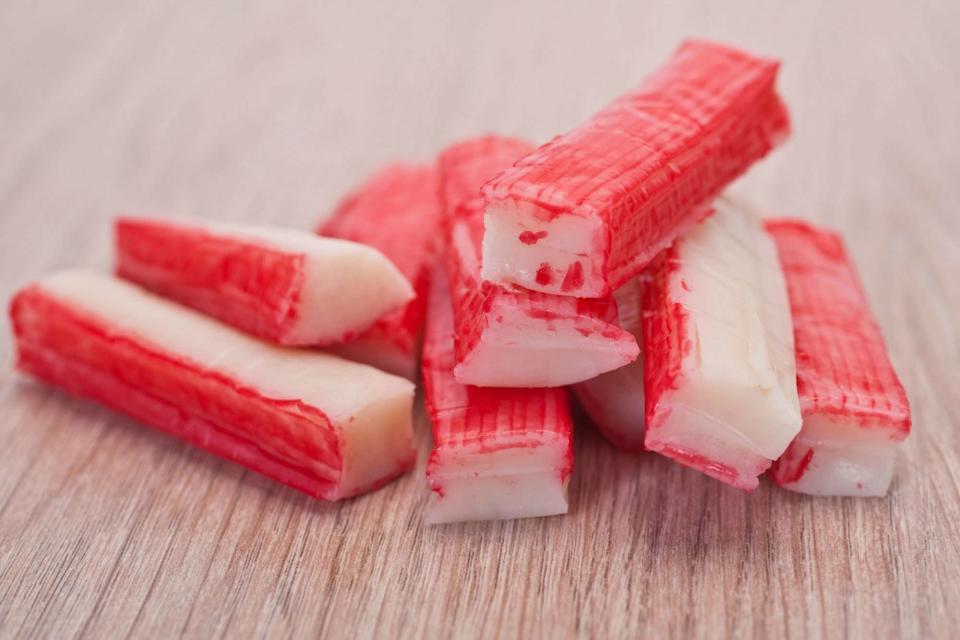What Is Imitation Crab? Find Out, Then Discover Our Best Imitation Crab Recipes
If you’ve eaten seafood salad, a California roll at a sushi restaurant, or frozen breaded fish, chances are high that you’ve eaten imitation crab.

Even if you’ve never added imitation crab to your grocery shopping list to cook with at home, if you frequent Japanese, Chinese, and other Asian-inspired restaurants, you’ve likely eaten your fair share of imitation crab recipes. First developed in Japan in the 1970s as a more budget-friendly, ocean-safe alternative to crab meat, it rose in prominence in America during the 1980s and beyond. It’s now a staple on many menus—including tucked inside many sushi rolls like the California roll—and is sold at nearly every supermarket to allow home cooks to create imitation crab recipes at home.
So what is imitation crab made of, and what makes it different from the shellfish it was created to substitute? Dive into everything you need to know about imitation crab, where you’ll find it on menus, how to use it in imitation crab recipes, and how its flavor and nutrition stack up to real crab.
Related: Crab Rangoon Mozzarella Sticks
What Is Imitation Crab Made Of?
While not real crab, imitation crab is made with natural fish protein. Most often, imitation crab is made of surimi, the flesh of white fish—commonly Alaskan Pollock, cod, or tilapia. The fish is deboned, minced into a paste, combined with other natural and artificial flavors, starch and/or egg whites (which work as thickeners), sugar, and salt, then heated and pressed into a tube shape that has a texture reminiscent of crab meat. Crab extract is sometimes added for flavor.
Surimi isn't just used for imitation crab. It also stars in fish sticks and breaded fish patties and has quite a long history in the culinary world. Japanese chefs dreamed up surimi more than 900 years ago, food historians estimate, as a way to cut down on food waste and make the most of leftover fish pieces.
The U.S. Food & Drug Administration (FDA) requires that all surimi products use the term "processed seafood" or "fish protein" on the label or menu to distinguish it from real fish or seafood. Imitation crab must be labeled as such or as "crab-flavored seafood" or "surimi seafood."
Imitation crab offers several benefits over its classic crab competition:
About ⅓ the cost of real crab.
Doesn't require removing meat from the shell.
Can help cut down on food waste and prevent any potential overfishing of crab (although catching sustainable white fish is still needed).
Tastes very similar to real crab.
Available in shredded, stick, or chunk form.
That said, real crab meat comes with several winning qualities, too.
Less processed.
Can buy it in a can, which comes pre-shelled and at a reasonably low price.
Offers about three times as much protein as imitation crab, as well as more vitamins, minerals, and heart-healthy omega-3 fats.
Now that you know what imitation crab is made of and why you might want to try it, how can you tell if your crab is real or not? Similar to how plant-based meat crumbles taste and perform similarly to regular ground beef, it can be challenging to notice the difference. The best way is to look at the label, ingredient list, or restaurant menu, or ask your server. Imitation crab products should say "imitation" somewhere on the label, and the ingredient list should be longer than just "crab." Grocery stores and restaurants may also call imitation crab "crab sticks," "crab-flavored seafood," "surimi seafood," or "krab."
Related: The 9 Best Meat Substitutes to Add Protein to a Plant-Based Diet
How to Use Imitation Crab
Besides in seafood salads, sushi rolls, hotpots, and more on restaurant menus, look for imitation crab in the refrigerated or frozen section of your supermarket. It is pre-cooked, no heating is required. But there are a wide variety of hot and cold imitation crab recipes you can add to your menu. It’s already starring in our fan-favorite DIY Sushirito and California Sushi Rolls, or try imitation crab to replace regular crab in any of these recipes:
How to Store Imitation Crab
After purchasing and before cooking imitation crab, store it in the refrigerator or freezer based on where you bought it. (Store at the same temp until ready to use. Thaw frozen imitation crab in the fridge overnight, then proceed with your imitation crab recipe.)
Unopened vacuum-sealed packages are usually safe to store in the refrigerator for up to two months or in the freezer for up to six months. Once opened, aim to polish off the imitation crab within three days. Loose imitation crab sold in trays in the seafood department should last three to five days in the refrigerator.
For more Better Homes & Gardens news, make sure to sign up for our newsletter!
Read the original article on Better Homes & Gardens.

